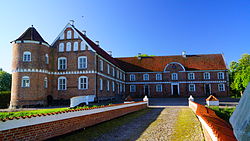Løvenholm Castle
Løvenholm Castle (Danish: Løvenholm slot; until 1647 Gjesingholm) is located east of Auning Church , in the parish of Gjesing on Jutland's eastern Djursland peninsula in Denmark .
Gjesingholm is mentioned for the first time in 1445, when the Johanniterkloster in Viborg , owner of the estate and some farmers, transferred the estate to the Benedictines of Essenbæk Abbey. After the Reformation , the monastery property was confiscated by the crown and transferred to Reichsmarschall Erik Eriksen Banner (1481–1554). He had organized the surveillance of the prisoner Gustav Vasa at Kalø Castle and led the Jutland nobility in the count feud (1534–1536) in the enforcement of the Reformation. The Banner family built the east wing and the corner tower in the north in 1576.
The mansion was then sold initially to Eske Brock (1560–1625) and in 1609 Gert von Rantzau auf Breitenburg (1558–1627) acquired and moved in. His son Christian zu Rantzau (1614–1663), 1650 count with the Vienna double diploma (Comitiv and Palatinat), in 1653 de facto imperial count on the Wetterau count bank of the Reichstag in Regensburg, as in 1654, was governor of the duchies in 1648 and became governor in 1661 the Danish crown. Christian Rantzau built the south tower in 1642. Since the coat of arms of the Rantzau shows a golden lion, they call the estate Løvenholm from 1647. It thus becomes part of the imperial county Rantzau created by imperial decree in 1649 , as well as the imperial county that was created in 1653. The time of the Rantzaus on Løvenholm ended in 1726 after the assassination of the 3rd Imperial Count Christian Detlef zu Rantzau in 1721, allegedly on behalf of or by his brother, the 4th and last Imperial Count Wilhelm Adolf zu Rantzau (1688–1734 Akershus Fortress / Norway) who was arrested by the Danes in 1726 and remained in custody until death. The Danish crown indicted him unlawfully in a Danish court, although as an imperial estate directly under the Empire, he was subject exclusively to the emperor and the highest imperial courts. An illegal and secret inheritance contract with the Danish crown, which the second imperial count Ditlev zu Rantzau had concluded - in the event of a lack of male heirs, the imperial county should go to the Danish crown - did not withstand the complaint of the sister Catharina of the two brothers: she became the entire property restituted, but with the catch that she had to bear the court costs of 230,000 Reichsthalers. She had to sell a lot to preserve Breitenburg. Drage, for example, acquires the Danish crown and gives it to King CHRISTIAN VI's brother-in-law, Friedrich von BRANDENBURG-KULMBACH, for their wedding. In the same way, in 1732 LOEVENHOLM came into the possession of Frederik Danneskiold-Samsoe (1703–1770), now elevated to the rank of Danish liege count .
After a few stops in between, Løvenholm Castle came into the possession of Waldemar Uttental, who also owned Gammel Estrup , in the late 1920s . He planned the Løvenholm Fonds School, a version of the Jutland Herlufsholm Boarding. However, this could not be realized and Løvenholm is now used for training and research in agriculture and forestry.
Web links / literature
- Løvenholm Slot
- Rantzau (Karl von), The Rantzau House: A family chronicle, Celle (JG Müller) 1865; Digital copy of the copy with the signature Gen-84-3 from the Bavarian State Library in Munich, print without indication of the author; whose name is handwritten under the title; www.digitale-sammlungen.de
Coordinates: 56 ° 27 ′ 6.3 " N , 10 ° 26 ′ 41.9" E


